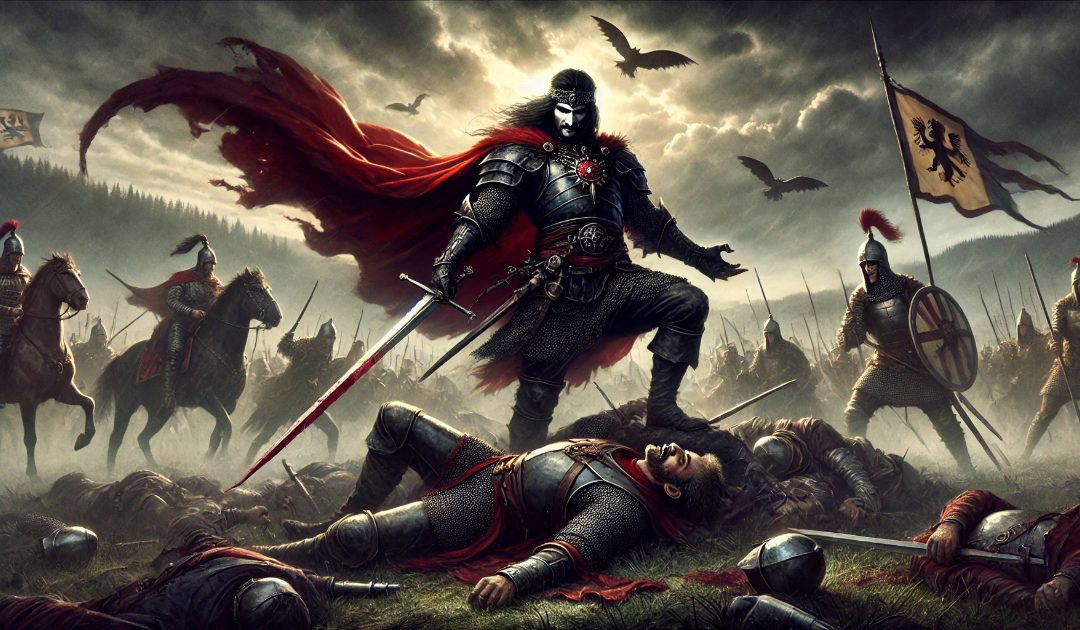The On This Day website tell me that on 26th November 1476 Vlad III, known to history as Vlad the Impaler or Vlad Dracula, with the help of Stephen the Great and Stephen V Bathory defeated Basarab Laiota to become ruler of Wallachia for the third time. His legacy is a blend of terrifying real-life events and sensationalized stories, leaving a mark on history as both a bloodthirsty ruler and a national hero. Born in 1431 in Sighișoara, Transylvania, Vlad became the ruler of Wallachia (a historical region of modern-day Romania) during a time of constant political upheaval and threats from the expanding Ottoman Empire.
Early Life and Rise to Power
Vlad was the son of Vlad II Dracul, a member of the Order of the Dragon, a chivalric group founded to defend Christian Europe against the Ottoman Turks. The moniker “Dracula” means “son of Dracul,” giving rise to his famous surname. As a child, Vlad and his younger brother, Radu, were sent as political hostages to the Ottoman Empire to ensure their father’s loyalty. This experience was traumatic, fostering a deep hatred for the Ottomans and shaping Vlad’s later ruthless approach to governance.
After the death of his father and older brother, Vlad sought to reclaim the throne of Wallachia, which he managed to do multiple times amidst fierce political rivalries. His most significant reign lasted from 1456 to 1462, during which he became notorious for his brutal methods of maintaining power.
The Terror of the Impaler
Vlad III earned the nickname “Țepeș” (the Impaler) for his preferred method of execution: impaling his enemies on large wooden stakes. This gruesome technique was not only a punishment but a psychological weapon designed to instill fear. One of his most infamous acts involved impaling an estimated 20,000 Ottoman prisoners outside the city of Târgoviște as a warning to Sultan Mehmed II. The sight was so horrifying that the advancing Ottoman army reportedly turned back in fear.
Beyond the battlefield, Vlad’s cruelty extended to his own people. He was known for a draconian sense of justice, punishing thieves, corrupt officials, and even minor offenders with impalement. According to legend, he placed a golden cup in the central square of Târgoviște, which remained untouched for years, a testament to his iron rule over crime.
Defender of Christendom
Despite his ruthless tactics, Vlad is considered a national hero in Romania for his staunch resistance against the Ottoman Turks. In a time when much of Eastern Europe was falling to Ottoman forces, Vlad’s military campaigns helped to protect Wallachia’s sovereignty. His daring “Night Attack” in 1462, where he led a surprise raid against the Ottoman camp, is still celebrated as a brilliant, if brutal, military maneuver.
The Dracula Myth
Vlad the Impaler’s legacy took on a new life in the late 19th century when Irish author Bram Stoker published his Gothic horror novel Dracula. While Stoker’s Count Dracula is a vampire inspired by European folklore, the character’s name and some elements of his backstory were drawn from Vlad III. The historical Vlad, however, was not a vampire but a man whose real-life deeds were often exaggerated in Western European pamphlets that painted him as a bloodthirsty tyrant.
Death and Legacy
The exact details of Vlad’s death remain a mystery. Some sources claim he was killed in battle against the Ottomans in 1476, while others suggest he was assassinated by rival factions. His head was reportedly sent to Sultan Mehmed II as proof of his demise. The location of his final resting place is uncertain, with legends suggesting he may have been buried at the Snagov Monastery or Comana Monastery.
Today, Vlad the Impaler is remembered as both a national symbol of resistance and a figure of horror. His life story, a blend of historical fact and legend, continues to captivate and terrify, making him a subject of countless books, films, and scholarly debates. Whether seen as a hero or a villain, Vlad III’s enduring legacy proves that history can be as complex and captivating as any work of fiction.

